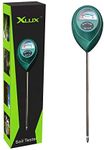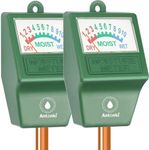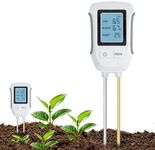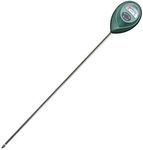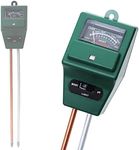Buying Guide for the Best Soil Moisture Meters
Choosing the right soil moisture meter is essential for maintaining the health of your plants, whether you're a home gardener or a professional landscaper. A soil moisture meter helps you determine the moisture level in the soil, ensuring that your plants receive the right amount of water. To make an informed decision, you need to understand the key specifications and how they relate to your specific needs.Measurement RangeThe measurement range of a soil moisture meter indicates the spectrum of moisture levels it can detect, usually expressed as a percentage or a scale from dry to wet. This spec is important because it determines the meter's ability to provide accurate readings for different types of soil and plants. For general gardening, a meter with a basic range (e.g., 0-10) might suffice. For more precise needs, such as in agriculture or specialized gardening, a wider range (e.g., 0-100%) is preferable. Choose a range that matches the moisture levels typical for your plants and soil type.
Probe LengthThe probe length refers to how deep the meter can measure moisture in the soil. This is crucial because different plants have roots at different depths. Shorter probes (around 4-6 inches) are suitable for potted plants and shallow-rooted plants. Longer probes (8 inches or more) are better for deeper-rooted plants and outdoor gardens. Select a probe length that matches the root depth of the plants you are monitoring.
Display TypeThe display type of a soil moisture meter can be analog or digital. Analog meters have a needle that points to a moisture level on a scale, while digital meters provide a numerical readout. Analog displays are simple and often more durable, making them suitable for basic gardening needs. Digital displays offer more precise readings and may include additional features like backlighting or data logging, which are useful for more detailed monitoring. Choose a display type based on your preference for simplicity or precision.
Additional FeaturesSome soil moisture meters come with additional features such as pH measurement, light measurement, or temperature sensors. These multi-functional meters can provide a more comprehensive understanding of your soil conditions. If you are looking to monitor multiple aspects of your soil, a meter with these additional features can be very beneficial. However, if you only need to measure moisture, a simpler model without these extras might be more cost-effective and easier to use.
Durability and Build QualityThe durability and build quality of a soil moisture meter are important for ensuring long-term use, especially if you plan to use it frequently or in outdoor conditions. Look for meters made with sturdy materials like stainless steel probes and water-resistant casings. High-quality meters are less likely to break or malfunction, providing more reliable readings over time. Consider the environment in which you will be using the meter and choose one that can withstand those conditions.
Ease of UseEase of use refers to how simple and intuitive the soil moisture meter is to operate. This includes factors like the readability of the display, the simplicity of the controls, and the clarity of the instructions. A user-friendly meter is especially important for beginners or those who prefer straightforward tools. Look for meters with clear, easy-to-read displays and simple operation to ensure you can quickly and accurately measure soil moisture without confusion.
